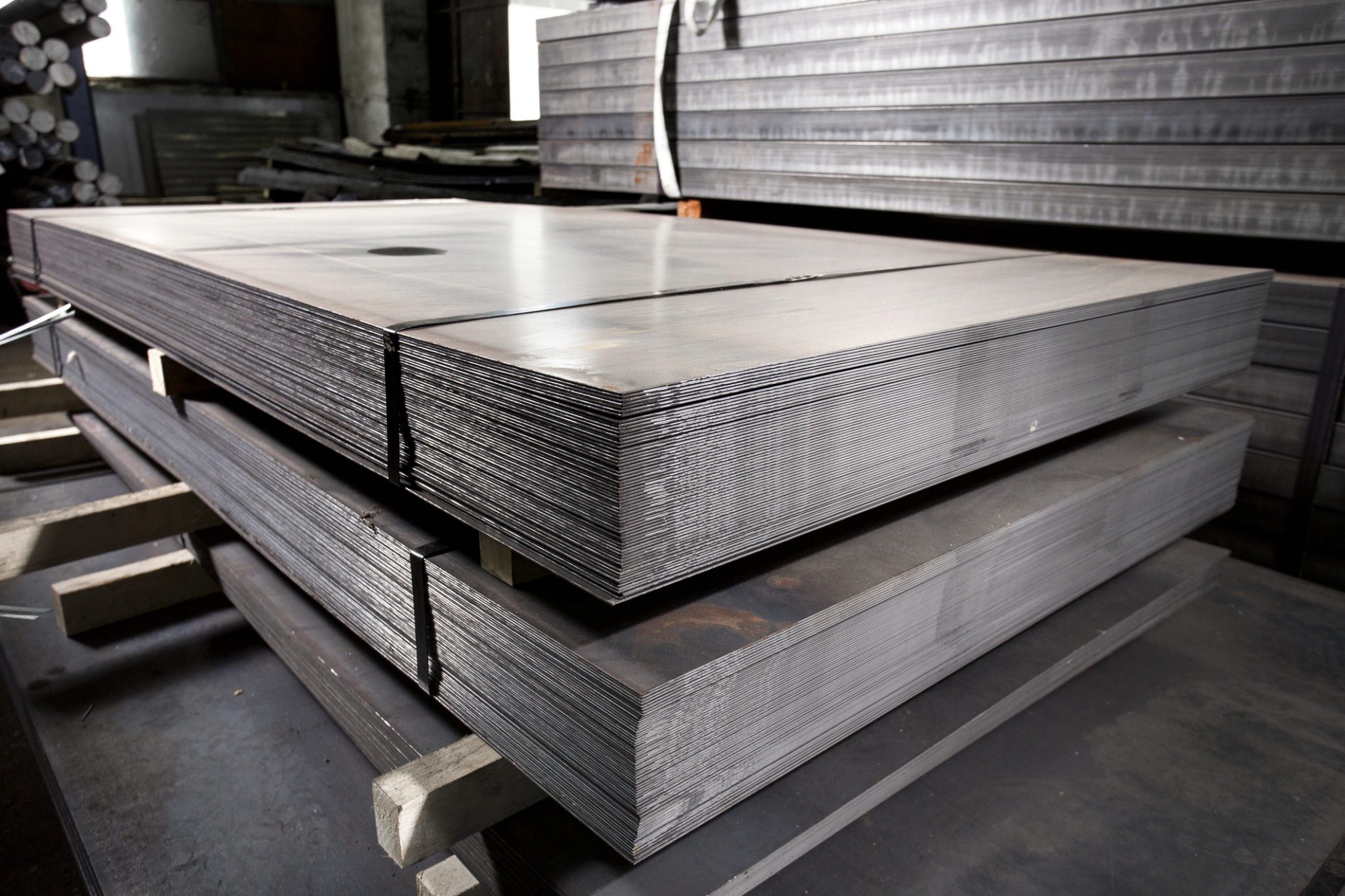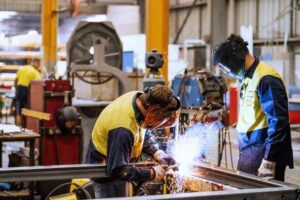If you work with metal, you are probably well aware that each type of metal comes in multiple grades that refer to its composition. Bar stock and sheet metals are assigned a set of identifying digits. These numbers reveal the metal’s alloying elements and family.
Two projects may call for carbon steel, but one uses 1010 grade steel and the other grade 1045. Aluminum for a storage tank may be grade 3003, while aluminum for automotive parts is grade 2014. Standard sheet metal grades share information about the metal’s makeup, offering insights into its strength or ability to be worked.
According to the World Steel Association, there are more than 3,500 grades of steel available. Additionally, the Aluminum Association counts over 530 registered aluminum alloy compositions. With so many options for each metal, how do you know which grade to choose?
Standard sheet metal grades help fabricators determine which metal alloys to use for each application. In this guide, we analyze the meanings behind steel, stainless steel and aluminum sheet metal grades.
Grades of Steel
Steel is a mix of iron and carbon. Other alloys, along with the amount of carbon, determine a steel’s grade. Before we dive into steel grades, let’s break down the categories of steel.
- Carbon steels are made of carbon and iron with only trace amounts of other elements. They make up the majority of steel produced.
- Alloyed steels contain other elements in addition to carbon and iron. These steels may contain nickel, copper or chromium, for example.
- Stainless steels have high corrosion resistance because they are made of 10 to 20% chromium. They appear shiny and are often used for home appliances.
- Tool steels are made with tungsten, cobalt and vanadium. They are resistant to heat and wear, which is why they are an excellent choice for manufacturing equipment and tools.
Of the steels listed above, carbon steel is commonly used in structural materials. Buildings, bridges, pipelines and machine parts, like gears and axles, are usually made from carbon steel. We can place carbon steel into three categories based on its carbon content:
- Low carbon steel, or mild carbon steel, contains up to 0.3% carbon.
- Medium carbon steels are made of 0.3 to 0.6% carbon.
- High carbon steels have a carbon content greater than 0.6%.
In the next section, we will jump into carbon steel and alloyed steel metal grades.
Cracking the Code: Carbon and Alloyed Steel Metal Grades
Back in the 1930s and 40s, the Society of Automotive Engineers (SAE) and the American Iron and Steel Institute (AISI) worked together to develop specifications for steel. Under SAE/AISI standards, carbon and low-alloy steel grades are four-digit numbers. Today, these standards are no longer written and managed by AISI but by SAE alone.
What does the SAE’s four-number specification mean? What do carbon steel sheet metal grades tell us?
1st Digit: Primary Alloy Elements
The first digit identifies the primary alloy element. For example, metals with 1XXX grades are primarily carbon. The steel grades chart below shows which digits refer to which primary alloys.
| First Digit | Steel Type |
| 1XXX | Carbon Steel |
| 2XXX | Nickel Steel |
| 3XXX | Nickel-Chromium Steel |
| 4XXX | Molybdenum Steel |
| 5XXX | Chromium Steel |
| 6XXX | Chromium-Vanadium Steel |
| 7XXX | Tungsten Steel |
| 8XXX | Nickel-Chromium-Molybdenum Steel |
| 9XXX | Silicon-Manganese Steel |
2nd Digit: Secondary Alloy Elements
Many types of steel consist of multiple alloys. The second digit refers to other alloying elements in the steel. The steel grade 10XX, for example, is plain carbon steel, while grade 13XX refers to carbon-manganese steel.
Final Digits: Carbon Content
The third and fourth digits display the steel’s carbon content in hundredths of a percent by weight. Plain carbon steel with a carbon level of 0.10 weight percent is 1010 grade steel. A higher carbon content increases the strength of the steel but reduces its ductility, which is its ability to be stretched into a wire.
Bringing It Together
Let’s take 1020 steel. The first digit tells us that it’s carbon steel, while the second lets us know that there aren’t any secondary alloys. The final two numbers show that the steel contains 0.2% carbon and would be considered mild carbon steel.
A Separate System: Types of Stainless Steel Grades
Stainless steel is composed of at least 10% chromium. The chromium forms a film on the steel’s surface that protects it from rust, heat and corrosion. Most stainless steel contains around 18% chromium.
There are several types of stainless steel, including:
- Austenitic stainless steel
- Ferritic stainless steel
- Martensitic stainless steel
Austenitic Stainless Steel
Austenitic stainless steels consist of chromium and nickel. Generally, this type of stainless steel is not magnetic, and you cannot treat it with heat. Austenitic stainless steel contains around 18% chromium with 8% nickel and less than 0.8% carbon.
Ferritic Stainless Steel
Ferritic stainless steel has a much lower nickel content compared to its austenitic counterpart. Alloys like chromium, molybdenum and titanium make up this steel. Most ferritic steels have about 12 to 17% chromium and less than 0.1% carbon.
Martensitic Stainless Steel
Martensitic stainless steel is magnetic and heat treatable. This type of steel is composed of 11 to 17% chromium with up to 1.2% carbon and 0.4% nickel.
SAE Stainless Steel Grading System
Unlike carbon and alloyed steels, the SAE grades stainless steels using only three digits. The first digit identifies the steel family or class referred to as its “series.” The table below displays the types of stainless steel grades.
| Series | Type of Stainless Steel |
| 100 | Austenitic |
| 200 | Austenitic; Chromium-Nickel-Manganese alloys |
| 300 | Austenitic; Chromium-Nickel alloys |
| 400 | Ferritic and Martensitic; Chromium alloys |
| 500 | Heat-resisting; Chromium alloys |
Analyzing Aluminum Sheet Metal Grades
Most aluminum alloys combine iron, silicon, copper and manganese to adjust the metal’s strength or enhance other properties. Aluminum sheet metal grades identify alloy families and the metal’s composition. These grades include four numbers followed by a letter.
When you look at an aluminum sheet metal grade, the first digit refers to the metal family or series. The letters that follow tell how the aluminum was processed.
Series of Aluminum Alloys: The First Digit
Use the following sheet metal grade chart to understand the series of aluminum.
| Series | Alloys | Properties |
| 1XXX | Pure Aluminum | High conductivity, workability and corrosion resistance |
| 2XXX | Aluminum-Copper | Heat-treatable, high strength, and high toughness |
| 3XXX | Aluminum-Manganese | Moderate strength and workability |
| 4XXX | Aluminum-Silicon | Lowers melting point without brittleness |
| 5XXX | Aluminum-Magnesium | Moderate to high strength, good weldability and good resistance to corrosion |
| 6XXX | Aluminum-Silicon-Magnesium | Heat-treatable, versatile, highly formable and weldable |
| 7XXX | Aluminum-Zinc (May include Magnesium, Copper or Chromium) | Heat-treatable and high strength |
What’s Behind the Letter?
Aluminum grades are followed by a letter, and that letter refers to the temper, or hardness, of the alloy. Each letter shares how the alloy was treated to achieve its properties.
Here are a few letters you will see in aluminum grades:
- O = Aluminum was annealed at the mill.
- T = Aluminum was thermally treated.
- H = Aluminum was work-hardened (or strain-hardened).
T-Tempers
| “T” Number | How the Alloy was Tempered |
| T1 | Naturally aged after cooling |
| T2 | Cooled, cold worked and then naturally aged |
| T3 | Solution heat treated, cold worked and then naturally aged |
| T4 | Naturally aged after solution heat treatment |
| T5 | Cooled and then artificially aged |
| T6 | Artificially aged after solution heat treatment |
| T7 | Solution heat treated and overaged |
| T8 | Solution heat treated, cold worked and then artificially aged |
| T9 | Solution heat treated, artificially aged and cold worked |
| T10 | Cooled, cold worked and then artificially aged |
H-Tempers
H-Tempers include two or more digits. The first digit indicates how the aluminum was work-hardened.
| “H” Numbers | How the Alloy was Tempered |
| H1 | Work-hardened only |
| H2 | Work-hardened then partially annealed |
| H3 | Work-hardened then stabilized |
H-tempers often include a second digit to show that the aluminum was work-hardened to a certain degree.
- 2 = ¼ hard
- 4 = ½ hard
- 6 = ¾ hard
- 8 = fall hard
- 9 = extra hard
The Unified Number System (UNS)
In addition to the SAE system, the American Society of Testing and Materials (ASTM) created identifiers to unify current grades used by organizations like SAE, AISI and the Aluminum Association.
You may see metal grades with six-digit numbers. These numbers are a part of the Unified Number System (UNS). Several UNS metal grades share the same first three digits as their respective SAE grades.
Below are examples of UNS categories:
- Aluminum alloys: A00001 to A99999
- Carbon and alloy steels: G00001 to G99999
- Copper alloys: C00001 to C99999
- H-steels: H00001 to H99999
- Stainless steel alloys: S00001 to S99999
UNS grades are not specifications. They were created to help avoid confusion in the industry by having one system to catalog and record materials.
Choose the Right Sheet Metal Grade
In this guide to sheet metal grades, we’ve addressed standard SAE metal grades for materials you may need for your next fabrication project: carbon steel, alloyed steel and stainless steel. We also laid out the Aluminum Association’s information about aluminum alloy families. At Metaltech, our highly-skilled team will help you determine which type and grade of metal you need.
Are you looking for a custom metal fabrication shop?
Request a quote from Metaltech today. Our team designs and produces custom component parts that meet your desired form, fit and function. Reach out to kick-start your metal manufacturing project.




